The pandemic lockdown that forced us all to work-from-home was a true shock to the system for most people who hadn’t worked a full day via videoconferencing. There was a whole new visual language to learn, a whole new way to train our brains, and a fresh source of insecurity-causing visuals to put out there for the world to see.
In those initial few weeks, before we knew how to use filters and ring-lights, our personal lives were laid bare to all our co-workers. All of a sudden, you knew who in the office were cat people, who were Yankees fans, and who lived in a home that seemed far nicer than what you thought they would live in.
It was somewhat interesting (and perhaps a welcome distraction) to have a view into people’s personality by way of their real “home office” background. And we all saw things we probably shouldn’t—dishes strewn everywhere, spouses walking by after just getting out of the shower. And these were just the things we saw when the other person knew their camera was on!
After a while, videoconferencing app companies developed features that made it easy to choose a “false” background that made it look like you’re really working from a seaside cottage or an art-deco interior worthy of a Wall St. Tycoon. It was whimsical while also providing an important layer of privacy.
In a recent meeting, I joked as people from different parts of the world in different organizations all had the same “modern office” false background. Someone on the call remarked thankfully, “Well, you wouldn’t really want to see what is behind me—laundry and underwear hanging to dry!”
But wait, I thought to myself. What if there is a way (or becomes a way), after all these meetings are recorded (and way too many are), to leverage the latest AI technology to remove the false background overlay and reveal the actual background? After all, your video camera is certainly capturing the real background, and it is only software that is putting a false background onto it. It’s a little unsettling, especially for those who have grown to be comfortable with their messy room now masked by the backgrounds they use on, say, Microsoft Teams.
Well, perhaps there is a better use of AI technology to reveal the unseen? And here it is!
RMail AI can reveal amazing information to senders of email about the journey of their email—like where, when, and how each email is being viewed or how popular it is. It will even reveal whether or not a particularly important email is being actively eavesdropped on by cybercriminals!
You’ve taken all sorts of precautions to protect your email content. But what if you deftly encrypt an email just to have the recipient forward it to others? What if those others have nostalgia for their email passwords, using something like “paSsWord1!” and, as a result, the email becomes actively eavesdropped on by cybercriminals? Wouldn’t you want to know? With RMail AI and RPost’s Email Eavesdropping™ detection service that plugs into your existing email system (e.g. Microsoft Outlook, Exchange, Gmail), you’ll get notified instantly! With just normal Microsoft and/or other email providers, you’d never know.
In this rapidly evolving digital world, we may take for granted that some of the privacy tools we use day-in and day-out are really just thin, easily-undone, layers of software. But rest assured that no such thin layers exist when you trust your email privacy and security to RMail.
Feel free to contact us to learn more about RMail AI and RPost’s Email Eavesdropping™ detection service.

December 19, 2025

December 12, 2025

December 05, 2025

November 21, 2025

November 14, 2025